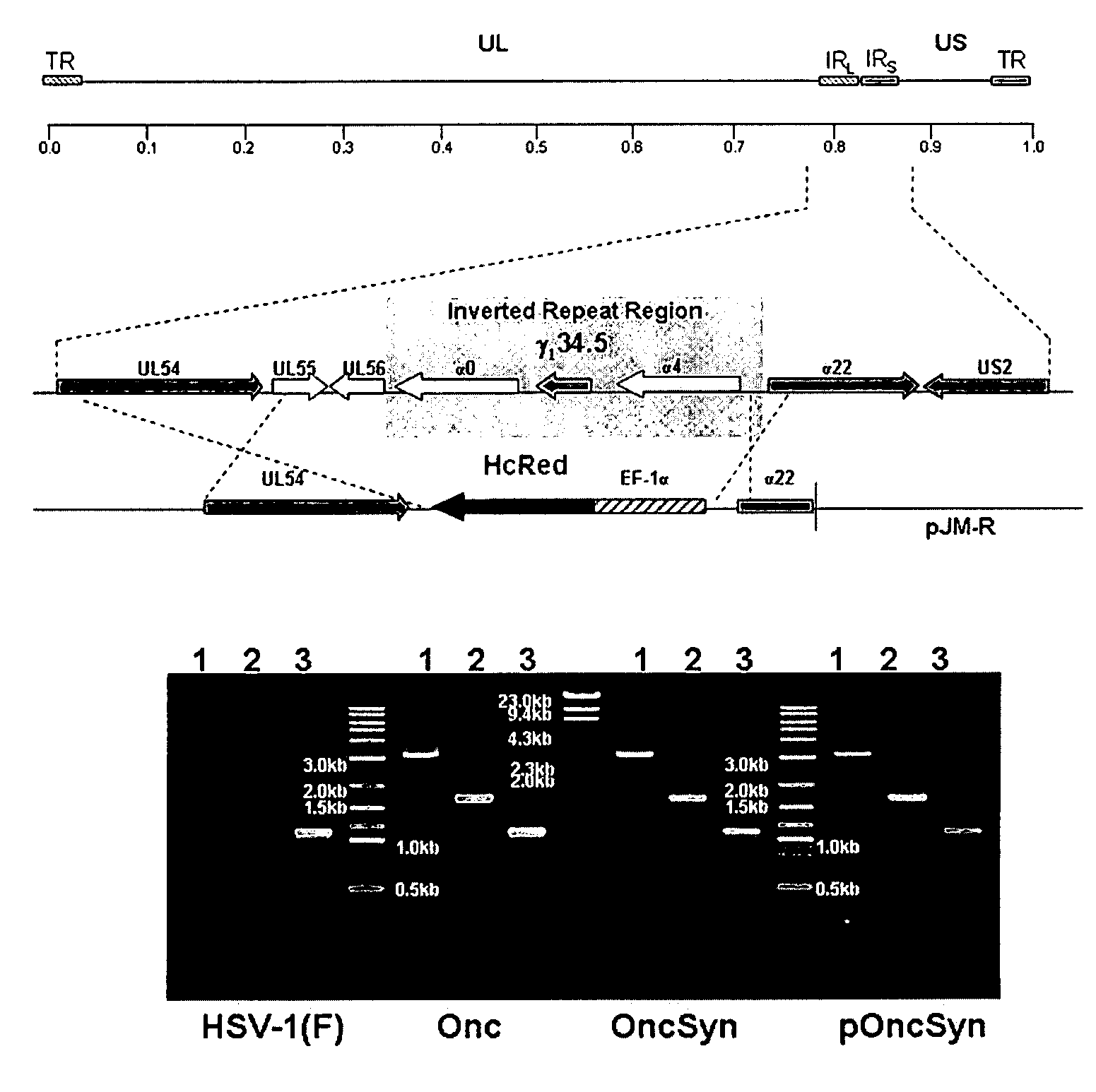Synthetic Herpes Simplex Viruses Type-1 for Treatment of Cancers
a herpes simplex virus and cancer technology, applied in the direction of dsdna viruses, drug compositions, peptide sources, etc., can solve the problems of high morbidity and mortality, restrict the growth of the virus to cancer cells, and attenuate the virus, so as to achieve high replication and spread of the virus in cancer cells
- Summary
- Abstract
- Description
- Claims
- Application Information
AI Technical Summary
Benefits of technology
Problems solved by technology
Method used
Image
Examples
example 1
The OncSyn Virus
Materials and Methods
[0041]Cells, viruses and plasmids. African green monkey kidney (Vero) cells, human breast cancer cells (Hs578T) (Hackett et al., 1977), and mouse mammary tumor cells (4T1) (Aslakson and Miller, 1992) were obtained from the American Type Culture Collection (Manassas, Va.). The human breast adenocarcinoma line MDA-MB-435-luc expressing luciferase (MM4L) (Leuschner et al., 2003) was kindly provided by Dr. C. Leuschner (Pennington Biomedical Research Center, Baton Rouge, La.). Vero and Hs578T cells were maintained in Dulbecco's modified Eagle's medium (Gibco-BRL; Grand Island, N.Y.), supplemented with 10% fetal calf serum and antibiotics. 4T1 cells were maintained in RPMI 1640 medium (Hyclone, Logan, Utah) containing 10% FBS. The cultures were maintained at 37° C. in a humidified atmosphere of 5% CO2 / 95% air. MM4L cells were cultured with Leibovitz's L-15 medium (Hyclone, Logan, Utah) containing 10% FBS. These cells were cultured in tightly closed fl...
example 2
OncSyn
Construction and Characterization of Oncolytic HSV-1 Mutant Viruses Onc and OncSyn
[0049]To attenuate HSV-1(F), but at the same time allow for efficient replication within tumor cells, a strategy was designed to delete a large portion of the HSV-1(F) genome containing one of the two alleles of the immediate early genes α4 and α0, as well as the virulence gene γ1 34.5. The strategy was similar to the one previously used for the construction of the R7020 recombinant virus, in which an approximately 16 Kbp genomic region encompassing the UL56, α0, γ1 34.5, and α4 genes was deleted. The deleted genomic region of the R7020 was replaced with a herpes simplex virus type-2 (HSV-2) DNA sequences coding for viral glycoproteins gD, gG, gI and a portion of gE, as well as a gene cassette expressing the viral thymidine kinase (TK) gene under the α4 promoter control (Meignier et al., 1988). In contrast to the R7020 recombinant virus, the Onc virus was designed to contain a gene cassette codin...
example 3
OncSyn
Phenotypic and Replication Characteristics of the Onc and OncSyn Viruses
[0055]The plaque morphology of the Onc and OncSyn viruses was examined on Vero, as well as on cancer cells of different lineages including the MDA-MB-435S-luc (MM4L) (human breast tumor-derived), Hs578T (human breast tumor-derived) and 4T1 (mouse mammary tumor-derived) (see Example 1 above). Both viruses (Onc and OncSyn) produced plaques emitting strong red fluorescence on all cell lines tested. FIG. 3 illustrates the plaque morphology of the Onc and OncSyn viruses. Vero (A, B) and MDA-MB-435S-luc (C, D) cells were infected with either Onc (A, C) or OncSyn (B, D) viruses. Individual viral plaques were photographed at 48 hr post infection using a fluorescence microscope at 100× magnification.
[0056]Importantly, both Onc and OncSyn viral plaques were substantially larger on both MM4L (FIG. 3: C, D) and Hs578T (not shown) cells in comparison to Vero cells (FIG. 3: A, B).
[0057]To better visualize the extent of ...
PUM
| Property | Measurement | Unit |
|---|---|---|
| Therapeutic | aaaaa | aaaaa |
Abstract
Description
Claims
Application Information
 Login to View More
Login to View More - R&D
- Intellectual Property
- Life Sciences
- Materials
- Tech Scout
- Unparalleled Data Quality
- Higher Quality Content
- 60% Fewer Hallucinations
Browse by: Latest US Patents, China's latest patents, Technical Efficacy Thesaurus, Application Domain, Technology Topic, Popular Technical Reports.
© 2025 PatSnap. All rights reserved.Legal|Privacy policy|Modern Slavery Act Transparency Statement|Sitemap|About US| Contact US: help@patsnap.com



